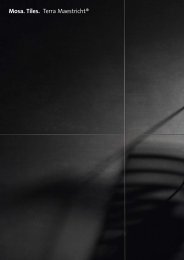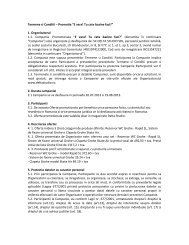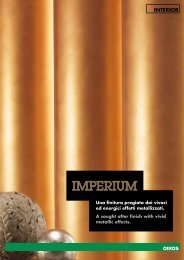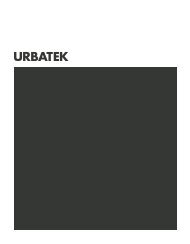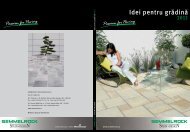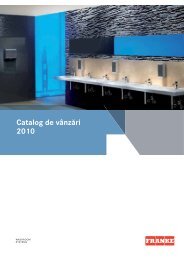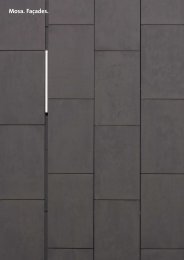Untitled - Delta Studio
Untitled - Delta Studio
Untitled - Delta Studio
You also want an ePaper? Increase the reach of your titles
YUMPU automatically turns print PDFs into web optimized ePapers that Google loves.
consigli di posa<br />
<br />
recomendaciones para el alicatado <br />
58<br />
la posa ottimale<br />
Il sottofondo deve essere correttamente<br />
predisposto: è necessario attendere i 28 giorni<br />
standard di essiccazione per i massetti e gli<br />
intonaci cementizi e 90 giorni per i getti di<br />
calcestruzzo. Il clima e gli agenti atmosferici<br />
<br />
a temperature inferiori ai 10°C i tempi di<br />
asciugatura aumentano sensibilmente mentre<br />
a temperature superiori a 35°C il rischio è una<br />
troppo rapida disidratazione del collante; per<br />
ovviare questi inconvenienti che mettono a<br />
rischio la tenuta della colla nel lungo periodo,<br />
si suggerisce di portare la temperatura degli<br />
ambienti entro l’intervallo consigliato almeno<br />
durante il tempo della posa e della corretta<br />
essiccazione.<br />
Per piscine, idromassaggi, vasche e piatti doccia<br />
è necessaria l’impermeabilizzazione con prodotti<br />
<br />
per valutare correttamente il comportamento<br />
della struttura.<br />
il sottofondo<br />
Il sottofondo deve essere pulito, piano e<br />
regolare, senza fessure e tracce di polvere in<br />
<br />
si consiglia di effettuare una rasatura correttiva<br />
<br />
per non compromettere la percezione delle<br />
colorazioni trasparenti del mosaico. Dopo la<br />
rasatura è necessario attendere almeno 24<br />
ore prima della posa. (Per rasature di spessore<br />
inferiore a 5 mm è possibile utilizzare lo stucco<br />
o il sigillante per le fughe).<br />
Non sottovalutare la preparazione del supporto di<br />
posa: ogni minimo difetto emerge visibilmente in<br />
<br />
Le indicazioni delle aziende produttrici di adesivi<br />
e sigillanti tengono conto dei parametri per la<br />
scelta del corretto adesivo: il supporto (muratura,<br />
legno, cartongesso, ecc...) la destinazione d’uso<br />
(piscina, living, cucina, ecc...) ed il modo d’uso<br />
<br />
Per i mosaici in vetro si suggerisce l’utilizzo<br />
di normali collanti bianchi con lattice per<br />
piastrelle, senza aggiunta d’acqua: questo<br />
impasto è conforme alle norme internazionali<br />
per la posa dei rivestimenti in vetro ed è il<br />
più indicato per evidenziare le peculiarità di<br />
materiali trasparenti.<br />
la posa<br />
<br />
<br />
completare il lavoro. La conservazione del<br />
materiale e l’ambiente di posa devono essere<br />
alla medesima temperatura. Tracciare sulla<br />
parete (o pavimento) linee guida ortogonali<br />
e perpendicolari per ottenere un reticolo di<br />
quadrati che contengono 3x3 fogli di mosaico.<br />
Stendere uniformemente la colla sul sottofondo<br />
con la parte liscia della spatola e rimuovere il<br />
materiale in eccesso con la spatola con denti<br />
quadri di 3x3 mm, tenendola inclinata e facendo<br />
leggera pressione sull’impasto. Il periodo di<br />
lavorabilità dell’adesivo è di 15/20 minuti, si<br />
suggerisce pertanto di stendere solo la quantità<br />
di colla necessaria a rivestire piccole porzioni<br />
(3x3 fogli alla volta).<br />
Posizionare i fogli di mosaico sullo strato di colla<br />
<br />
distanza tra le tessere sia la stessa di quella tra<br />
i fogli.<br />
Battere sul mosaico con la spatola gommata ed<br />
effettuare piccole correzioni laterali per allineare<br />
perfettamente le fughe.<br />
La colla non deve eccedere dalle fughe; se<br />
accade: utilizzare una spatola con denti più<br />
piccoli o pareggiare meglio il sottofondo o<br />
inclinare maggiormente la spatola dentata nella<br />
stesura dell’adesivo. Rimuovere tempestivamente<br />
<br />
mosaico con una spugna inumidita.<br />
stuccatura e pulizia<br />
Preparare Colorepoxy miscelando i due<br />
componenti ed applicare l’impasto con un<br />
frattazzo o spatola in gomma; riempire con<br />
estrema attenzione tutti gli interstizi tenendo<br />
conto della durata impasto del prodotto (circa<br />
45 minuti).<br />
Rimuovere l’impasto in eccesso con lo stesso<br />
<br />
spugna abbondantemente impregnata con acqua<br />
pulita entro 30 minuti dall’applicazione, in<br />
questa operazione è necessaria accuratezza nel<br />
non rimuovere lo stucco.<br />
I residui di fugante che permangono<br />
<br />
indurimento dello stucco dovranno essere<br />
rimossi con appositi prodotti. Non utilizzare<br />
spugne metalliche o abrasive. La pedonabilità<br />
avviene in circa 24 ore; la completa messa in<br />
<br />
attacco chimico, è di 4 giorni.<br />
I prodotti Mosaico+ sono resistenti e durevoli:<br />
si consiglia tuttavia di utilizzare per la pulizia<br />
ordinaria un panno morbido e detersivi non<br />
aggressivi.<br />
optimal installation<br />
The support structure must be correctly prepared:<br />
the standard waiting time to allow for drying is<br />
28 days for concrete screeds and cement plasters<br />
and 90 days for casting concrete. Climate and<br />
<br />
<br />
temperatures below 10°C, while at temperatures<br />
greater than 35°C adhesives dehydrating too<br />
quickly pose a risk. In order to overcome these<br />
potential problems which put the performance<br />
of the adhesive at risk over the long term, it is<br />
recommended to bring the temperature of the<br />
area to within the recommended range during<br />
installation and drying.<br />
<br />
necessary and possibly a leak test for swimming<br />
pools, hot tubs, bathtubs, and shower trays in order<br />
to correctly assess the behavior of the structure.<br />
the support structure<br />
<br />
even and must have no cracks or traces of dust<br />
on the surface. It is recommended to carry out<br />
a corrective skim coat if these conditions are not<br />
<br />
so as not to compromise the transparent colors<br />
of the mosaic. After the skim coat is applied it<br />
is necessary to wait for at least 24 hours before<br />
installation. (For skim coats less than 5mm thick<br />
it is possible to use grout or sealer for joints). Do<br />
not underestimate the importance of preparing the<br />
support structure for the installation: every minimal<br />
defect is visible on the surface, compromising the<br />
<br />
instructions take the parameters for the choice<br />
of the correct adhesive into account: the support<br />
structure (masonry, wood, plasterboard, etc…),<br />
purpose (swimming pool, living room, kitchen,<br />
<br />
showroom, etc…).<br />
Normal white adhesives with latex for tiles without<br />
any added water are suggested for glass mosaics:<br />
this mixture is in conformity with international<br />
regulations for the installation of glass wall tiles<br />
and is the most highly recommended to bring out<br />
the unique qualities of transparent materials.<br />
installation<br />
Make sure that all of the material inside of the<br />
<br />
The areas where the material is stored and where<br />
the installation will take place must be at the same<br />
temperature. Trace octagonal and perpendicular<br />
<br />
of squares that will contain the 3x3 mosaic sheets.<br />
Spread the adhesive out in a uniform layer on the<br />
support structure with the smooth part of a spatula<br />
and remove any excess material with 3x3mm<br />
notched trowel while holding it on an inclined<br />
angle and applying light pressure to the mixture.<br />
The adhesive can be manipulated for a period of<br />
15-20 minutes. Therefore it is recommended<br />
to spread out enough product to complete small<br />
sections.<br />
(3x3 sheets at a time).<br />
Place the sheets of mosaics on a layer of adhesive<br />
pressing delicately and making sure that the<br />
distance between the tesserae is the same as the<br />
distance between the sheets.<br />
Tap on the mosaic with a rubber spatula and<br />
make small lateral adjustments to perfectly align<br />
the joints. The adhesive should not come out of<br />
the joints; if this occurs, use the trowel with the<br />
smallest notches or level the support structure<br />
better or incline the notched trowel at a greater



